![[propb.jpg]](https://blogger.googleusercontent.com/img/b/R29vZ2xl/AVvXsEh07UmUKUXvWzqtbGY_3omBsgt6yF9ql_lhDd_IWiRw_0n6vMcrqjP7nJR7yrLfKv8V15oFAOyQDGkuL_OzWS0gUZJG1-scd5Et8X5jMUrC_aYvk5hP7qD7_wfv0NRtL3WIyXP-xDTPJ9du/s1600/propb.jpg)
![[propa.jpg]](https://blogger.googleusercontent.com/img/b/R29vZ2xl/AVvXsEifWXMx5BBxmIVJtYiwEiOu3S2NcgUxE6jg-6SbQSVor_9-oNT8r0JfHWJda7NgAgvVuTo-KZwVvg4_WK2U_bLzXUF0SvFSpsK-_FFj8lcu57rizopgwgb4fwCXPnKSin-RTuKptIWqm1i7/s1600/propa.jpg)
Bog mu se kao 14-godišnjaku obratio u letećem tanjuru. Ali to je izjavio nakon što ga je žena ostavila i sa sobom odvela njihove 11 djece. U njegovom psihoaktivnom stripovskom svemiru više nije bilo mjesta za "razvedene kurve".
royalrobertson.tumblr.com/
ROYAL
2011, 7:48
This video by Malcolm Hearn expands footage from the documentaryMAKE to present an encounter with the artist Prophet Royal Robertson. It is included in the exhibition Prophet Royal Robertson: NO PROUD BASTARDS - curated by Erik Parker and Scott Ogden at WHITE COLUMNS.
The Libra Patriarch Prophet Lord Archbishop Apostle Visionary Mystic Psychic Saint Royal Robertson
 | |
| Untitled work that's featured in the album art for Sufjan Stevens' The Age of Adz |
I don't think we've done any posts about any artists working in purely visual media, so lemme give it a shot and introduce you to Prophet Royal Robertson.
First off, let me make sure you don't try to read this as a review. This guy was one of those people that you could never ever figure out, especially with never having met him and only learning about him from various internet sources. So if i ever tried to review his work, it would inevitably be wrong.
So the story of Royal Robertson is an interesting one. He was born in Louisiana and apprenticed as a sign painter in his late teens. To make a very long and sorrowful story short, he married Adell Brent in 1955 and had 11 children with her. After 19 years of marriage, Adell left Royal for another man, taking all 11 children with her and her new man to Texas.
When his marriage ended, Royal shrank into a reclusive existence and developed paranoid schizophrenia. He began recording visions that he had which he said were given to him by God. He claimed that he received the first one when he was merely 14 years old, in which God appeared to him flying a space ship. Once his marriage ended, he began recording his visions in his art, often depicting futuristic scenes foretelling the end of days.
Royal was obsessed about the End of Days and the Book of Revelation. His works were very often accompanied by misogynistic rants against his ex-wife Adell and women in general, claiming them to be "whores" and "adulteresses". His visions in which aliens warned against the dangers of adultery and sex made Royal believe that there was a global female conspiracy and that Adell's betrayal would ultimately lead to the end of the world.
Royal also developed a belief that he was a prophet sent to lead a new Zion. He often signed his art with any combination of parts of the title "Libra Patriarch Prophet Lord Archbishop Apostle Visionary Mystic Psychic Saint Royal Robertson".
As an impoverished, self-taught artist, Royal's main media were magic markers, colored pencil, tempura paint and glitter on wood, paper, or poster board. His style was very much his own, though it sometimes drew very heavily from comic book style drawing. His main recurring themes were the Book of Revelation and other biblical references, aliens, futuristic landscapes and vehicles, and the treachery of "adulterous whores" and infidel spouses. His home was decorated with many signs warning off "whores" and "bastards" and denouncing the name of his ex-wife. The interior of his house was covered with his art. Most of it depicted Adell and he even had several shrines devoted to her.
Though apparently scorned by his neighbors, Royal retained friends and visitors said he was a very friendly man. His art is held in many private collections as well as in the Smithsonian American Art Museum and other major art museums. His art is also featured in the cover and interior art of Sufjan Stevens' 2010 release The Age of Adz. He is also featured in a documentary about 4 self-taught fringe folk artist that will be released this summer.
I don't know about you guys, but I would have really liked to have met Royal Robertson before he died. I also would really like to own a piece of his art. He never had any formal education in art and was constantly in a state of poverty, so his work is obviously not of the best quality. But, it so perfectly captures a tortured, maddened soul. Besides, who knows? Maybe he's right. Perhaps women will be the death of us all.
-The Surveyor goldt0ngue.blogspot.com/






Prophet Royal Robertson
November 23, 2011 by redtreetimes
Prophet, speak what’s on your mind
If you’ve heard of artist Royal Robertson, chances are you heard of him the same way I did: via Sufjan Stevens. Sufjan’s most recent album, The Age of Adz, was inspired by Royal Robertson’s art and features one of his pieces on the album cover.
Robertson (1936-1997) was born and lived most of his life in Louisiana. He left school at age 13 and in his late teens apprenticed as a sign painter in the western US. Later in his life, when his wife of 19 years – and mother of his 11 children – left him for another man and took all their children to Texas with her, he descended into paranoid schizophrenia. He declared himself a prophet and began to record his visions in his paintings. Frequent themes in his paintings included spaceships and aliens, futuristic cities, Biblical and religious references, numerology and misogyny, the latter apparently spurred by his wife’s betrayal.
In this video, Sufjan Stevens talks about Robertson and performs “Get Real, Get Right” with some of Robertson’s images appearing on the screen behind him.
| Royal Robertson (1936 - 1997) |
 Except for a few years spent traveling in the west, Royal Robertson lived his entire life in Louisiana . A former field hand and sign painter, Robertson said that he was “born drawing.” In 1955, he married Adell Brent and fathered eleven children with her. When abandoned by Adell after twenty years of marriage, Robertson descended into an uneasy existence, scorned by his neighbors and overcome by misogynistic rage. Armed with magic markers, paints, colored pencils and ball point pens, Robertson immersed himself in creating a fantasy world depicted on poster board, responding to God’s command that he condemn the evil ways of women. Except for a few years spent traveling in the west, Royal Robertson lived his entire life in Louisiana . A former field hand and sign painter, Robertson said that he was “born drawing.” In 1955, he married Adell Brent and fathered eleven children with her. When abandoned by Adell after twenty years of marriage, Robertson descended into an uneasy existence, scorned by his neighbors and overcome by misogynistic rage. Armed with magic markers, paints, colored pencils and ball point pens, Robertson immersed himself in creating a fantasy world depicted on poster board, responding to God’s command that he condemn the evil ways of women.
Each drawing is a window into the tormented world of the self-proclaimed “Prophet” Royal Robertson. Bible verses and religious references mix with futuristic visionary images in highly eccentric, provocative works chronicling his paranoia and unsettled mental state. His themes include images of aliens and spaceships, architectural drawings of dream houses and temples in futuristic cities, superhero figures, and portraits of Adelle and other Amazon women. Robertson embellishes the colorful drawings with rambling, ranting texts, sometimes in cartoon-like balloons, that leave no doubt about the judgment reserved for adulterous whores and unfaithful spouses.
Many of these works include calendars chronicling agonizing memories of his unfaithful wife and their spoiled marriage in brief journal notations scribbled in each date's block. Robertson's preoccupation with numerology and biblical prophecies of earth's final days as found in the book of Revelation are also evident.
Robertson created an extraordinary environment within his modest home in Baldwin, Louisiana. On the exterior, painted signs warned “whores” and “bastards” to stay away. The interior of his home was densely crowded with his drawings pinned to every available wall. In August 1992, the home was completely destroyed by Hurricane Andrew. With the help of two collectors who helped him file papers with the federal government, he recovered from his losses. In 1997, Royal Robertson died suddenly, just as he was finally reconciling his relationship with two of his children.
|
 |  | No. 1; ca. 1988-90 Markers, ink, paint on posterboard, 22" x 28", SOLD Side A: Flying Saucer in black cloud – “Bible of Leviticus” Side B: Architectural drawing in b/w |
 |  | No. 3; ca. 1988-90 Markers, ink, paint on posterboard, 22" x 28", SOLDSide A: Space buildings, red frame – “I keep on dreaming I went away to a far way land” Side B: Calendar (May 1989 AD) – “No good mother fuckers defiled” |
 |  | No. 4 ca. 1988-90 Markers, ink, paint on posterboard, 22" x 28", SOLD Side A: Spacescape with building on tall hill, blue frame – “Was Aug 16 – nite 1965 AD” Side B: Spaceship with yellow ground and silver sky |
 | No. 11; ca. 1988-90 Markers, ink, paint on posterboard, 22" x 28", $800Side A: Full length Adell at night with flowers and fence in freeform border
Side B: Black cartouche - outline of another full length Adelle faintly visible under paint (not shown)
| |
 |  | No. 16; ca. 1988-90 Markers, ink, paint on posterboard, 22" x 28",SOLD
Side A: Spacescape with building and orange tree stumps in cartouche
Side B: Date list, text in red – “July 4 1980 to 1985 AD”
|
 |  | No. 18; ca. 1988-90 Markers, ink, paint on posterboard, 22" x 28", SOLD
Side A: Space man with beard, red eyes, glitter, in green border
Side B: Text with large black eye – “The eternal-angle”
|
 |  Detail side A Detail side A Side B Side B | No. 19; ca. 1988-90 Markers, ink, paint on posterboard, 22" x 28", $800
Side A: Spacescape with crescent moon; "Patriarchal Prophet Royal Robertson / Libra Realism Arts"
Side B: simple black outline
|
 |  | No. 20; ca. 1988-90 Markers, ink, paint on posterboard, 22" x 28", $1000 SOLD Side A: “In God driveth a flying saucer” Side B: Black ink figure of angel and soldier. Very detailed text -- "Go call Dr. Martin Luther King and Mrs. Alberta Crazy"... |
Prophet Royal Robertson: ‘No Proud Bastards’‘Project Stewart Home’
By ROBERTA SMITH
Prophet Royal Robertson (1931-97) is not going gently into any outsider-art canon. As demonstrated by the first in-depth exhibition of his art in New York, the efforts of this Louisiana sign painter are too raw and unruly, his style too bristling and changeable. Looking at his work, you appreciate the sublime consistency of artists like Martin Ramirez or James Castle, but this in turn clarifies Robertson’s singular and noisome wildness, the volatile fusion of image, language and unvarnished emotion that he achieved.
He believed in space aliens and was fluent in the Bible and furious with his former wife, Adell. (“No Divorce Whore’s Allowed” announces one of the first signs in the exhibition.) Festooned with texts in tight, curling calligraphy, some drawings suggest pages from crazed illuminated manuscripts. Others isolate the complex geometric, implicitly metallic forms of spaceships, cars or weapons. In contrast he had a thing for sparkle and a penchant for sweetly colored futuristic architecture. In one of the best, more anomalous images, he uses shades of yellow and amber and patches of stippling to render a delicate vista of mountains whose thin, twisted peaks suggest narwhal tusks. There’s definitely a fingernails-on-chalkboard quality to Robertson’s sensibility that is part of its allure and perhaps a limitation. But as an introduction, this is a memorable show that whets the appetite for further exposure. It has been organized by the New York-based artists Scott Ogden and Erik Parker, who discovered Robertson’s work in Raw magazine when they were art students and met him the year before he died.
In terms of resistance to easy absorption, Robertson’s work is more than matched by White Columns’ second show: the first American exhibition devoted to Stewart Home, the British oppositional artist, latter-day Situationist, writer, editor, filmmaker, punk-rock musician, anti-art prankster and all-around contrarian who has been a thorn in the side of the British art and literary establishments for nearly 30 years. The exhibition includes a video interview concerning Mr. Home’s 1990-93 Art Strike, during which he purportedly abstained from cultural production, and copies of his fanzine Smile and his parodist pulp-fiction, including a sculpture made from stacks of his 2005 novel “Down and Out in Shoreditch and Hoxton.” A brochure written by Mr. Home explains a lot, if not everything. For that, there is his lavishly detailed Wikipedia entry, which also appears to be his handiwork. In all, few cultural producers seem to have been as busily and consistently canon-averse as Mr. Home.




Prophet Royal Robertson (1931-1997), originally a sign painter by trade, covered every inch of his Baldwin, Louisiana home and yard with apocalyptic hand-made signs and paintings. Visitors and passersby alike were greeted with large, weather-beaten signs warning, “All Crazy Persons Keep Off Lot” and “No Divorced Whores Allowed”. However once you got past these foreboding walls of language, an entirely different world opened up inside his small home. Shrines dedicated to his both beloved and despised ex-wife, Adell, were pushed up against walls that were lined floor to ceiling with poster board renderings of future cities, space autos, couples engaged in sex, weaponry, and calendars chronicling his daily woes and visions. Referencing sources as disparate as the Bible, science fiction magazines, pornography, and cheap tabloid newspapers, his work managed to graphically illustrate the daily concerns that occupied his mind, both real and imagined. More than a reclusive, self-proclaimed prophet, Royal believed himself to be a “Libra Artist, Mystic, Psychic, Lord, and Saint.” He lived in a world where daily visions blended seamlessly into a waking life spent obsessively documenting his otherworldly adventures. The resulting drawings and writings provide direct access into the mind of an evidently troubled, yet visionary individual who perhaps unintentionally created some of the most extraordinary ‘Pop’ art of the 20th Century.
– Scott Ogden and Erik Parker





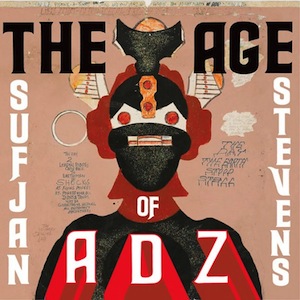
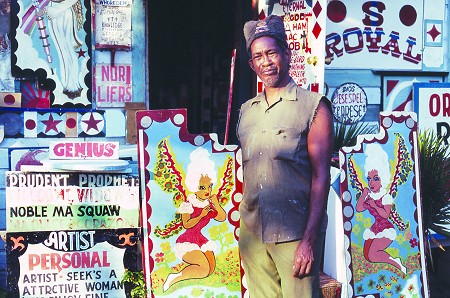
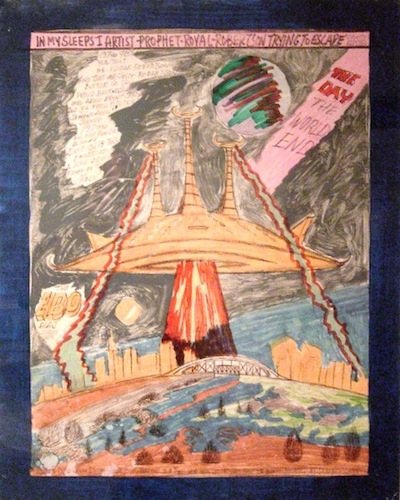
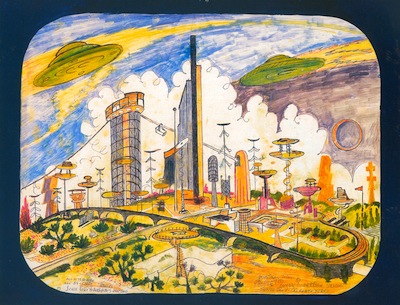


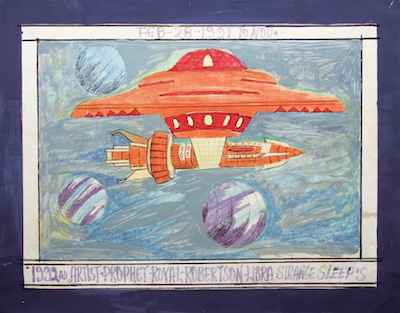
Nema komentara:
Objavi komentar